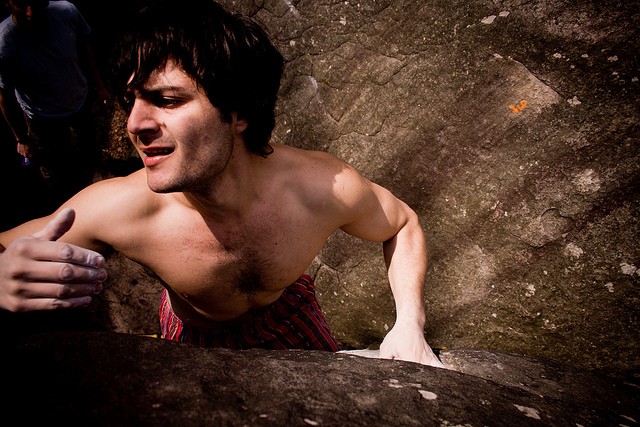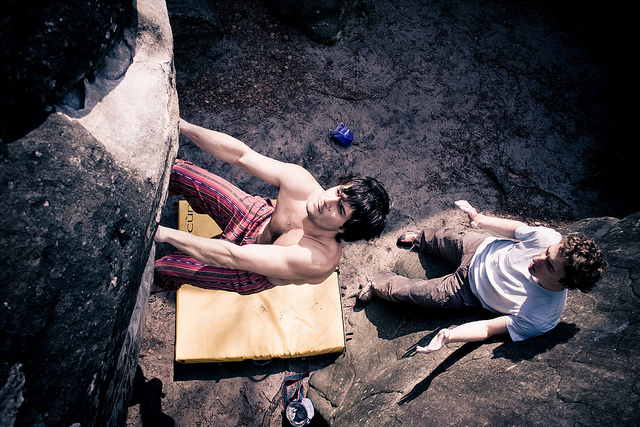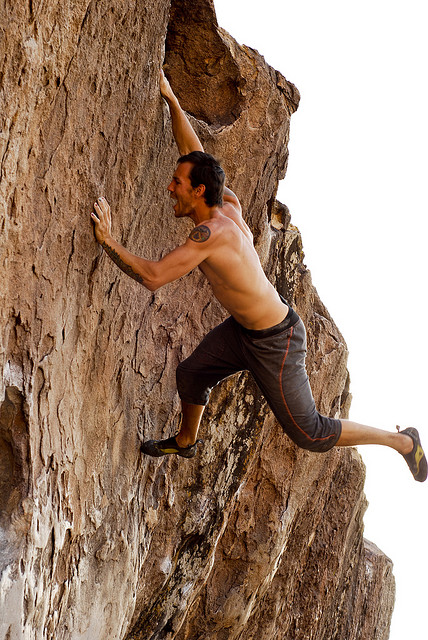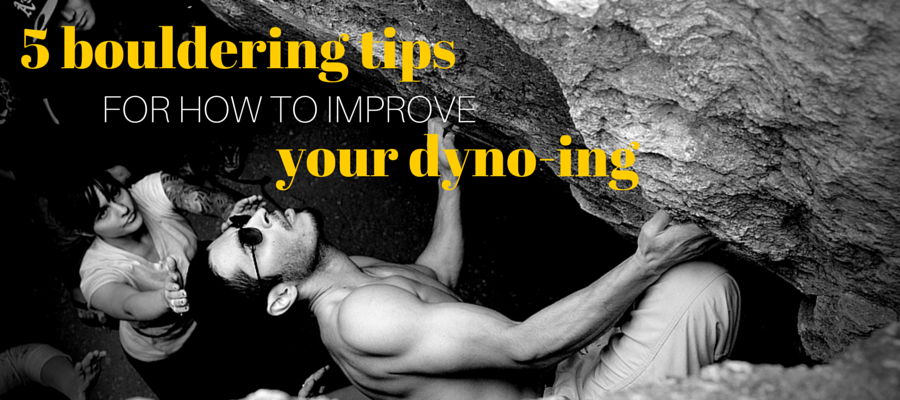How To Get Better At Bouldering
The simplicity of bouldering makes it an undeniably fun and accessible activity. Unlike the gear-intensive needs of sport and traditional climbing, all you need for a good time when it comes to climbing large-but-not-that-large rocks are a crash pad and those very boulders themselves … maybe a brush if you're feeling fancy. You don't even really need a partner (but spotters are pretty nice to have).
Oh, but I forgot one thing: you also need that burning desire to try hard. Like, really, really effin' hard …
Related:Campfire: Turn on the "Try Hard"
While the concept of bouldering is simple, the art of this climbing style is not. We've all seen the ripped frat dudes that show up to the climbing gym for the first time, so sure that this whole bouldering thing—and climbing in general—will be easy. Inevitably, they're gripped in about half a second from clenching their giant biceps so hard on a V0-, and soon look like an embarrassed dog with their tail between their legs.
Meanwhile, the tiny 8-year-old girl next the them is totally crushing the hardest problem at the gym. Ego destruction at its finest. (See:Ashima Shiraishi).
Baby crusher, crushing:
Any climber knows the importance of strength, but that technique is where the magic happens.
With boulder problems, you have an immense spectrum of rock types and movement styles at your disposal, which each necessitate utilizing diverse strategies to solve. Inherently, our body types often lend our skills to one area, but there's no reason why you shouldn't attempt to improve your abilities in the other realms. By improving various techniques in your weakest areas, you can become a better all-around boulderer.
So today, let's get down it, and go over strategies for tackling one of the most common weaknesses (definitely mine) of all in bouldering …

"Why is this so hard?!" Photo: Pim Horvers
Related:Off the Deck: Learning to Love Highballs
Standard Dynamics (Dyno-ing)

Photo: Pim Horvers
Ah yes, the good ole' dyno.
When bouldering, powerful movement is often the name of the game, particularly on vertical-to-overhanging rock. This doesn't necessarily mean brute strength—in fact, dynamic movement can actually help to cope with the lack of lock-off strength—but rather the ability to make gymnastic moves to assist you in reaching your next hold. For us shorter folk, learning this techniques is absolutely key if we ever want to get to the top of one of these large rocks.
Even if you can make the move statically, oftentimes you can save considerable energy by making one larger movement—in other words, even when your body is screaming no, really, YOU SHOULD JUST DYNO!
5 key rules for dyno success:
1. Push with your legs rather than pulling with your arms.
Your legs are considerably stronger than your arms (unless you're aforementioned frat-bro dude), meaning they can help launch you much further, while also saving you the strength you'll need in your arms to finish out the problem. Figure out where to place your feet for the most efficient leverage points.
This generally lies between where your feet feel too low to push off of, and where they are uncomfortably high. Aim for a spot where your feet won't cut. Sometimes though—you won't have the luxury of this choice.
Michael O'Rourke showing double dyno-ing prowess on Dino Dyno (V12):
2. Use your arms to direct and pivot your body.
Sometimes in climbing, you don't need to use your arms to pull down! When dyno-ing, the goal of your arms is to pull the rest of your body in.
Try and keep your arms as straight as possible, while pivoting from your start holds. For more overhanging problems, you'll be able to extend them further out. Accordingly, for more vertical faces—where you want to keep your body closer to the wall—you'll need to bend them more. For vertical climbs, do your best the flatten the arc that your body forms in dyno-preparation position.
Remember: legs should push up, rather than out!
Related:Rock Climbing Footwork Technique

Note those straight arms! Good technique. Photo: Pim Horvers
3. Crouch one time, then go big!

The "thank God" jug. Photo: Dana Le
Simpler than it ever feels, it's a two-punch move that proves ridiculously hard to commit to. Often, you'll let out a …
I'm supposed to do what!?!?
The key here is not to turn away from the problem. Instead, drop your legs low enough to give you the power you'll need to leap for the next hold—then fire away. The breathing strategy I suggest in this stage, is to inhale in the crouch, and exhale on the push-off.
Summed up in the wise and poetic words of Lil Jon and The Eastside Boyz:
Get low,
Get low,
to the windows to the wall (TO THE WALL).
4. Commit, commit, —and dammit— COMMIT ALREADY!
I know, it's super hard. Trust me—this is my biggest personal crux. But this is precisely where you need to engage the internal depths of that magical thing inside you that we as climbers refer to as,try hard.
Try visualizing yourself grasping that jug (hopefully it's a jug …) and sending that problem. Don't half-ass dyno, because half-ass dyno attempts never work. Harness your power and own that movement!
Tommy Caldwell dyno-ing on the Dawn Wall:
5. Do your best to not to over-dyno.
First you're telling me to go big, now you're telling me to restrain myself?!
Not exactly. While hitting a hold where you want it and how you want it sounds hard to control, your body—with the immense help of those weird squishy round things on your face called eyes—are pretty adept at assessing the right amount of power to release.
It might take a few attempts to gauge what qualifies as the right amount to push off, but aim to drop onto the top of your target hold as gently as possible.
When you're body overshoots, it can make it significantly harder to latch onto the hold, and could result in injury … And no climber on the planet wants to deal with injury.
Was this article helpful? Have any extra tips for us dyno-ing impaired folk? Leave them in the comments below.
How To Get Better At Bouldering
Source: https://mojagear.com/5-bouldering-tips-for-how-to-improve-your-dyno-ing-technique/
Posted by: porterfieldthenthe.blogspot.com


0 Response to "How To Get Better At Bouldering"
Post a Comment